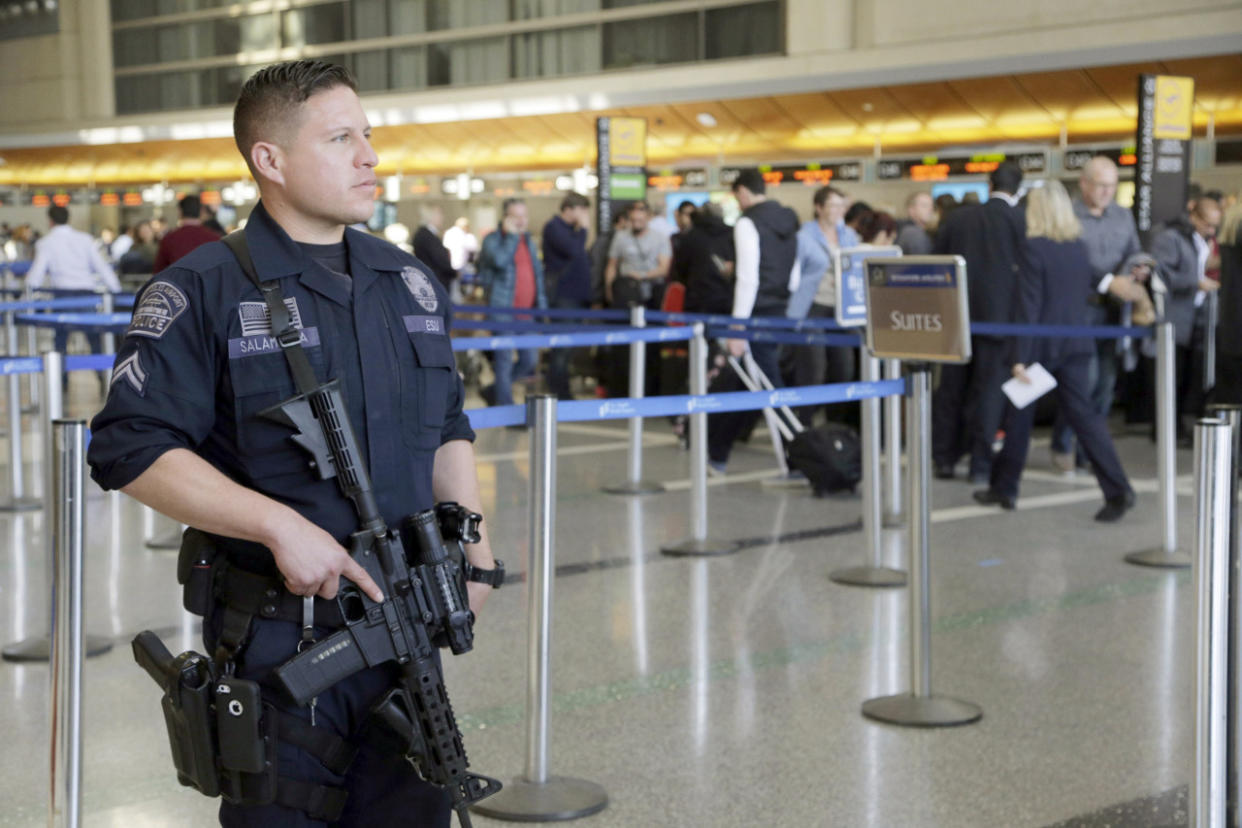There is no ‘specific, credible’ threat against the U.S. Does that mean everything’s fine?

Police officers guard a terminal on Nov. 24 at Los Angeles International Airport as people travel in advance of the Thanksgiving holiday. (Photo: Nick Ut/AP)
In the immediate aftermath of the massacre in Paris, for which the so-called Islamic State claimed responsibility, many media reports have quoted U.S. officials as saying that there is no specific, credible threat of a similar attack against the United States. But obviously that doesn’t mean ISIS poses no danger to America or Americans.
So what is a “specific, credible threat”? Yahoo News asked three retired U.S. government officials, each of whom regularly briefed or advised the president on intelligence matters, to shed a little light on a commonly used term that the public still doesn’t necessarily understand very well 14 years after 9/11.
“We often see specific threats that aren’t credible. We also see credible threats that aren’t specific. But what concerns counterterrorism officials the most is when you have a specific threat that comes from a credible source,” explained Matt Olsen, former head of the CIA’s counterterrorism center.
Another former senior intelligence official, who requested anonymity, described those categories this way: Specific, noncredible threats come from people who either don’t intend to act on their supposed plans or lack the ability to do so. A credible, nonspecific threat might come from a violent group with a history of targeting Americans and the means to do so but may be worded only in general terms “like ‘we need to hit the Americans.’” But when the aforementioned violent group talks about putting a bomb aboard a U.S.-bound plane, that’s a specific, credible threat.
A third official, who also asked not to be named, said that the best way to think of a “specific, credible threat” is “something we [the U.S. government] can act on to disrupt.”
As for how a threat acquires the ‘specific and credible’ label, the second anonymous official described a twofold process of intelligence reporting and intelligence analysis. Each vets the information about a potential threat.
If a human source comes to a U.S. intelligence agency with a juicy piece of information, the intelligence reporting part of this does two things: judges the source’s track record and how that source obtained that particular piece of information, the official said.
“Are you hearing this from a particular human asset with a 10-year record of always being right? Or are you hearing this from an asset you’ve worked with for one or two years and whose record is 50-50?” the official said. “And then how did they get this particular information? Did they hear it directly from the aide to the prime minister who was in the room when the prime minister said it? Or did they hear it from a friend of the aide or even two to three people removed?”
“If the acquisition chain is short, maybe they heard it firsthand, and they have a very good track record, then the information would be considered credible,” the official explained. Both anonymous officials cautioned that intelligence officers also have to keep in mind whether their source might be trying to influence U.S. policy or have another built-in bias that might be shaping the information that they are providing, making it less credible.
“The ‘specific’ is whether the information gives you where, when, how, what,” the second official said.
The intelligence analysis process reaches a judgment about what might happen and then a separate judgment on the confidence in that prediction, the second official said. He offered a more prosaic example: “I have high confidence that it’s going to rain tomorrow because we’ve been told by a source who controls the rain that it will.”
The analysis also puts a specific piece on intelligence into a broader context, including information from other sources, to determine credibility.
In the end, the third official said, the phrase is mostly a way to reassure Americans.
“You almost never hear ‘yes, we have a specific, credible threat’ unless we’re beating in their [the potential perpetrators’] door,” the third official said.


